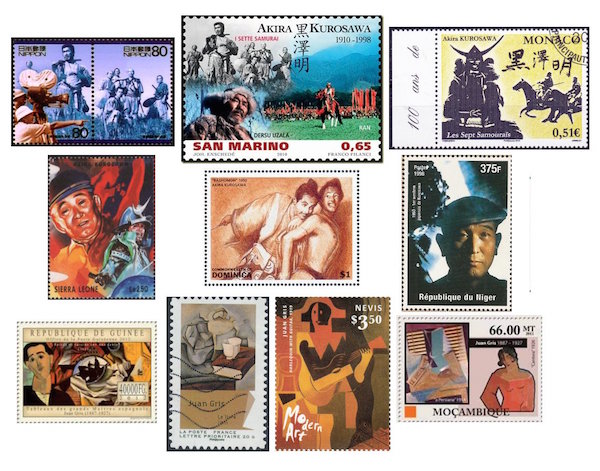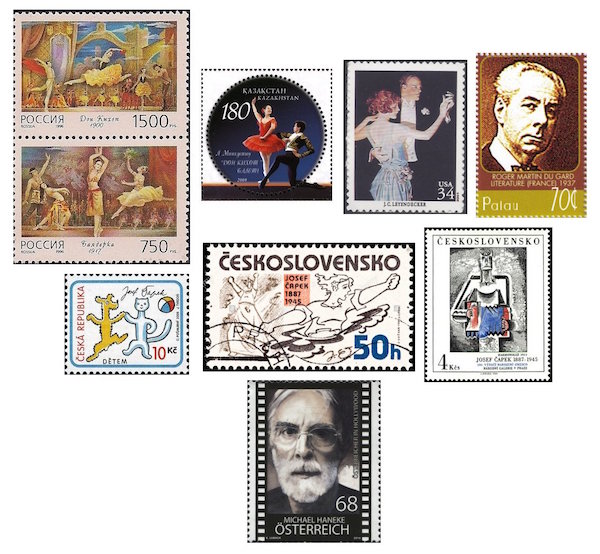The Arts on the Stamps of the World — March 23
An Arts Fuse regular feature: the arts on stamps of the world.

By Doug Briscoe
Today’s piece begins and ends with filmmakers, Akira Kurosawa topping our list, with Austrian director Michael Haneke, another serious auteur, coming last only because he was the most recently born of all our subjects today. Kurosawa (March 23, 1910 – September 6, 1998) was introduced to film at a very early age by his father, who, with insight uncommon at the time, considered both theater and film worthwhile as educational grist for the intellectual mill. Akira started as a painter and moved to film as a writer and assistant director until 1943, when he directed his first feature, Sanshiro Sugata. Five years later he cast Toshiro Mifune for the first time (in Drunken Angel, 1948) in what would become a fifteen-film partnership. That movie also established Kurosawa as an important filmmaker, but it was Rashomon (1950) that made his international reputation and paved the way for receptivity to other Japanese films in the West. Kurosawa was recognized with a Lifetime Achievement Oscar in 1990. He’s been honored on stamps from his native Japan, San Marino, Monaco, Sierra Leone, Dominica, and Niger.
Next up is the great Spanish Cubist painter Juan Gris, born José Victoriano González-Pérez on March 23, 1887, 130 years ago today, in Madrid. I wonder whether his early studies in engineering set the course for his later adoption of Cubism. His first work as an independent artist was as a contributor to various magazines, both in Madrid from 1902 to 1904 and in Paris from 1906 to 1910. In the meanwhile (literally, between those two periods) he studied painting with the academic artist José Moreno Carbonero, and it was in 1905 that he assumed the name Juan Gris. After making friends with Matisse, Braque, and Léger, he gave up illustration and two years later had exhibitions not only in Paris, but also in Barcelona, Berlin, and Rouen, all in 1912. I gather (the distinctions, frankly, are beyond my ken) he moved from Analytical Cubism to Synthetic Cubism to Crystal Cubism. Perhaps if he’d been born to a later generation he might have adopted Ice Cubism or Rubik’s Cubism. He also worked as a sculptor. Often ill from late 1925, Juan Gris died of renal failure on May 11, 1927, aged 40.
One may be excused for thinking that Ludwig Minkus (23 March 1826 – 7 December 1917) was Russian, given that, as official Composer of Ballet Music to the St. Petersburg Imperial Theatres, he was also known as Léon Fyodorovich Minkus, but in fact he was an Austrian. To confuse matters just a bit more, his father was Czech, his mother Hungarian, and both were Jewish. They converted to Catholicism just prior to their marriage. Minkus played violin publicly from the age of eight. In 1853, he accepted a position as conductor of an orchestra (of serfs!) that was…I suppose one would have to say “owned” by the Prince Nikolai Yusupov (whose grandson Felix would take part in the assassination of Rasputin). Minkus settled in Russia, serving as violinist, concertmaster, conductor, and Moscow Conservatory professor of violin. As early as the mid-1850s Minkus had found his métier as a composer of ballet music, including many pieces written for insertion into ballets by other composers. In 1866 he collaborated with Delibes on the score for La Source. His best known ballets, Don Quixote and La Bayadère, followed in 1869 and 1877 respectively. By the way, he played second violin in the first performance of Tchaikovsky’s String Quartet no. 1 (with the famous Andante cantabile). (Tolstoy’s famous tearful reaction occurred at a later performance.) Minkus retired in 1886 and left Russia in 1891 for his native Vienna. He died of pneumonia at the age of 91. There are no stamps honoring Minkus himself, but these refer to his works: the Russian ones were issued in 1996 in honor of choreographer Alexander Gorsky, with two of the four stamps showing scenes from Don Quixote (top) and La Bayadère (bottom); the stamp from Kazakhstan, also depicting Don Quixote, comes from a 2009 sheet commemorating that country’s National Ballet.

The brothers Joseph Christian and Francis Xavier (or James) Leyendecker were among the most prominent American illustrators of the first quarter of the 20th century, with Joseph (March 23, 1874 – July 25, 1951) taking pride of place with his Arrow Shirt account and his work for the Saturday Evening Post (pre-Norman Rockwell). Both of the brothers were born in a little town near Koblenz, Germany, and were taken when quite small to Chicago, where the clan was joined by a baby girl. Like so many others, Leyendecker studied at the Chicago Art Institute, then he and Frank moved on to Paris for further study, returning to the US in 1899; in that same year, J. C. did his first Saturday Evening Post cover. Eventually, over the course of nearly half a century, he would create 322 of them. (Rockwell literally did him one better with 323 and would one day serve as one of Leyendecker’s pallbearers.) J. C., as intimated above, also did a great many men’s fashion advertisements and came to be known as The Arrow Collar Man. From 1914 to the end of his life, he cohabited in New Rochelle with another man, which along with his concentration on men’s clothing ads has led some commentators to believe he was gay. I mention this only because our next subject is also thought by some to have been a “latent” homosexual, but again with uncertainty.
French novelist Roger Martin du Gard (23 March 1881 – 22 August 1958) won the Nobel Prize for Literature in 1937, mainly for his novel series The Thibaults. As for the gay angle, the relationship between the two main characters is decidedly romantic, albeit not explicit, and du Gard was a good friend of André Gide. There you have it. Case closed. (On the other hand, he was married with a daughter.) The first six parts of Les Thibault came out (you should pardon the expression) between 1922 and 1929, with the much longer final two volumes appearing in 1936 and 1940. It was twice made into television series in France. Du Gard also wrote plays and other novels, along with a memoir of Gide.

Czech artist Josef Čapek (23 March 1887 – April 1945) was also a writer like his brother Karel, but is better known as cartoonist and illustrator, though in his earlier days he painted in a Cubist manner. The brothers co-wrote plays and stories, and Josef himself wrote a play, several novels, and a number of essays on the value of untrained art, that is, art of the unconscious, of children, and of “primitive” peoples. The personal style of painting he developed is a sort of playful primitivism, which can be seen in his story collection All About Doggie and Pussycat, regarded as a classic of Czech children’s literature. (The stamp at left gives us one of his illustrations for the book.) Josef’s brother credited him with coming up with the term “robot” for his (Karel’s) 1920 science-fiction play R.U.R. (Rossum’s Universal Robots). Critical of Nazism, Josef was arrested by the occupying Germans in 1939 and sent to Bergen-Belsen, where he produced Poems from a Concentration Camp and where he died, sadly, just as the war was coming to a close. The center stamp conjoins two of his posters, Fire and From the Concentration Camp, and the one at right, from 1987, shows us his early painting The Accordionist of 1913.
Austrian director and screenwriter Michael Haneke (born 23 March 1942) won the Palme d’Or at the 2009 and 2012 Cannes Film Festivals with his pictures The White Ribbon (which also took Best Foreign Language Film at the Golden Globes) and Amour, which was also nominated for five Academy Awards, winning Best Foreign Language Film. After seeking his muse in acting and music, he turned to film criticism and television work, directing his first TV program in 1974. He is related by marriage to the actor Christoph Waltz, whose mother married Haneke’s stepfather. Haneke’s other films include Funny Games (1997) and Caché (2005).
A graduate of the University of Massachusetts with a B.A. in English, Doug Briscoe worked in Boston classical music radio, at WCRB, WGBH, and WBUR, for about 25 years, beginning in 1977. He has the curious distinction of having succeeded Robert J. Lurtsema twice, first as host of WGBH’s weekday morning classical music program in 1993, then as host of the weekend program when Robert J.’s health failed in 2000. Doug also wrote liner notes for several of the late Gunther Schuller’s GM Recordings releases as well as program notes for the Boston Classical Orchestra. For the past few years he’s been posting a Facebook “blog” of classical music on stamps of the world, which has now been expanded to encompass all the arts for The Arts Fuse.
